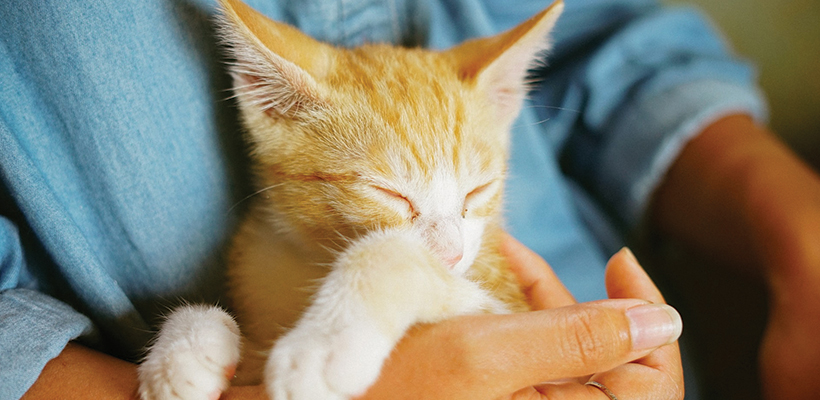
This article is contributed by guest writer, Emily G. (Author of Cattail Gardens).
How to Best Prepare Your Home & Heart for a Blind Cat
Cats are known for their sharp eyesight, but unfortunately not all felines have perfect sight. Some cats are born blind or become blind because of a health issue. Often cats experience trauma or injury that makes them blind. While caring for a blind cat takes a little extra effort, loving them does not.
Cats have an extremely strong sense of smell and hearing. In fact, cats can hear up to 100,000 hertz and have 200 million odor sensitive cells in their nostrils. To put that into context, humans can only hear 20,000 hertz and have five million odor sensitive cells in our nostrils. These two senses can compensate for the lack of sight in your cat, who actually won’t realize he or she is blind. They just think they’re a regular cat.
If you are ready to welcome a blind cat into your home, you may feel a bit overwhelmed. But – don’t be. By following the steps outlined in this article, your home and heart will be ready to take in your new blind kitty and give him or her the best life possible.

Photo Credit: Ömürden Cengiz via Unsplash
10 Steps to prepare for a lovable blind cat
When you are ready to bring your lovable blind cat home, follow these steps:
1. Keep them as an indoor cat
Blind cats need to remain indoor cats. Even if they have their claws, they will not be able to protect themselves outside alone, especially if they have health issues. They are also likely to become disoriented and confused. Blind cats can be taken outside, but they need to be supervised. Try walking them on a leash or purchasing a catio.
2. Help them get acclimated to your home
When you bring home a blind cat, you need to give them time to get acclimated. Yes, they can hear and smell their new space, but they will need time to learn the layout of your home. This may take days or weeks. Remember to constantly show your cat where their litter box, beds, and other items are located.
3. Don’t move things around too much
You can move your furniture if you have a blind cat. Just don’t move it too much, especially at the beginning of their time in your home. Make sure that they are completely oriented in your house before you move anything. And, never move their litter boxes or other important items.

Photo Credit: Marija Zaric via Unsplash
4. Clean your home often
Cleaning actually helps your blind cat more than you might think. Regular cleaning will cut down on smells, which can disorient your cat. Plus, regular cleaning ensures your house stays decluttered. This removes dangerous places for your cat to hide or get lost in.
5. Cat-proof your home
Blind cats need more supervision even in your home. You will want to block off any staircases and keep the toilet’s lid down. Approach cat-proofing as you would baby-proofing. Remove as many dangers that your cat will not be able to see as possible. This is a crucial step as it ensures the safety of your cat.
6. Make noise to let your cat know where you are
All cats startle easily. If your cat cannot see or hear you coming, they are likely to be very frightened. When you have a blind cat in your home, you must make noise. You don’t have to yell all the time, but you do want them to know where you are at all times, especially if you are approaching them.

Photo Credit: Manki Kim via Unsplash
7. Always make sure they stay oriented in your home
Many cats are cuddle-bugs that love to be picked up. You can still pick up a blind cat and carry them around. You will need to put them down in a location they can identify. If you take them to another room, put them in their litter box or bed. This will help your cat stay oriented throughout your home.
8. Keep their environment small until they get comfortable
This is an important step for all cats. Cats don’t like change. The pet experts at The Idle Cat advise that when you first introduce them to a new space, keep it small. “If you have a large house, just allow your blind cat in one or two rooms to begin with. As they start to understand the layout of those rooms, they will be much more curious and comfortable about scouting out the rest of your home.”
9. Get rid of pests
Make sure to do regular sanitization of both the special spot of your cat and the property itself. Carry regular checks for any signs of fleas both on your cat and the areas it visits the most.
10. Give them lots of love
Finally, get ready to give your blind cat lots of love. They make wonderful pets. Blind cats love to be touched, petted, and held. They want to know that you are there and that you love them – which shouldn’t be hard at all.

Amy Weber
December 3, 2020 at 4:53 PMBeautiful and enlightening article.
Natasha Ramirez
January 4, 2021 at 2:54 PMReally good tips!